
ABOUT U.S.
"Hotel Thousand and One Nights"

Lanciano and its surroundings are suitable to be reached for a historical, naturalistic or wine & food turism. A perfect mix of nature, history and art, that certifies a thousand-year old history You can see in many ancient villages, Churches, abbies and hermitages.
Thanks to its favorable position, Septe Castle can satisfy all the needs and so can welcome who likes the sea, who prefers the mountain, the cities of art, the festivals, the excellent cooking.
LANCIANO
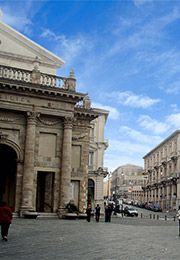 Lanciano is on the hills of the Sangro Valley and has very ancient origins: the archaeological finds dating back to the Neolithic and the most recent excavations have brought to light the remains of the " Anxanum", a large accommodation facility dated XII century BC, one of the oldest in Abruzzo, cited as a Roman station even by Julius Caesar.
Lanciano is on the hills of the Sangro Valley and has very ancient origins: the archaeological finds dating back to the Neolithic and the most recent excavations have brought to light the remains of the " Anxanum", a large accommodation facility dated XII century BC, one of the oldest in Abruzzo, cited as a Roman station even by Julius Caesar.
The heyday of Lanciano is reached between the XII and XV century, thanks to the development of the Roman "Nundinae", fairs held in the earlier months of the year on the Colle della Selva, where stood the temple dedicated to Apollo, and reached their maximum splendor in the Medieval period, when merchants who attended it came from all over the world and were very frequent exchanges with Venice and Ragusa.
First signs of crisis began in the period of maximum development of the city because of the struggle between the French and the Spanish, who mined the development of Lanciano. For this reason, Ferdinand of Aragon, in 1515, established with an edict that in Lanciano merchants of any origin or religion would enjoy broad protection and would be "safe and secure" throughout the exhibition period, during which was also elected a Mastrogiurato, to enforce the "Peace Fair" .
But in ‘600 Philip III deprived of this privilege the merchants and caused the gradual decline of the city .
By the Seventeenth century, Lanciano became a fief of Duke Alessandro Pallavicini and then, in a second step, of the D'Avalos del Vasto Marquis.
It was in the Twentieth century that Lanciano was enlarged and participated in the Second World War.
Today Lanciano is a well-known exhibition center recognized nationally and internationally and is also known to be the city of the first Eucharistic Miracle recognized by the Church, a miracle that took place in the Seventh century .
GUARDIAGRELE
 Despite the significant findings dating back to prehistoric times ( Caprafico districts and Comino), pre-Roman and Roman (Grele and Saint Lucia), the origins of Guardiagrele are still misterious. It is likely that , following the devastation made by the barbarian horde, here homesteaded a Lombard coterie with the intent to exploit the strategic potential of the site.
Despite the significant findings dating back to prehistoric times ( Caprafico districts and Comino), pre-Roman and Roman (Grele and Saint Lucia), the origins of Guardiagrele are still misterious. It is likely that , following the devastation made by the barbarian horde, here homesteaded a Lombard coterie with the intent to exploit the strategic potential of the site.
Later, the village knew illustrious lordships: among others, the Palearia, the Orsini and the Caracciolo di San Buono, who took turns to his guidance until 1747. The bombing of 1944 and the recent earthquake in the Sangro Valley ( in 1984) have undermined the integrity of the architectural heritage of the historic center, which can, however, still boast the Church of St. Francis, with its Fourteenth-century portal, the one of St. Nicholas, with internal Baroque and above all the collegiate Church of Santa Maria Maggiore, with Gothic exterior and Baroque interior. Not far from the center, in a cave-shrine, it is stored the tomb of Andrea Bafile , World War II hero.
VASTO
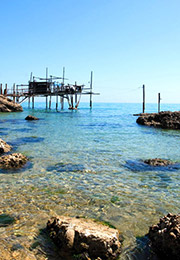 In Roman times Vasto was called Histonium. The city was plundered throughout history by many, including the Lombards and the Franks, led, in 802 AC, by Pepin the Short.
In Roman times Vasto was called Histonium. The city was plundered throughout history by many, including the Lombards and the Franks, led, in 802 AC, by Pepin the Short.
In the Fascist era the city's name was changed in Istonio with a clear reference to its Latin name. It was a fascist practice to attribute Latin names to cities and monuments, a nationalist and historicist tendency of the regime. Only in 1944, the city regained the name of Vasto.
Remarkable monuments in the city are the statue of Dante Gabriel Rossetti, poet and painter exiled patriot, the Cadorlesco Castle, the Aragonese Castle, the Tower of Bassano and St Joseph's Cathedral, to name just a few.
Vasto is also a pretty harbor station, suitable for a summer holiday: a place for a quiet relaxing holiday but also fun.
SAN SALVO
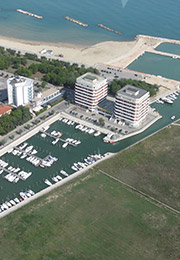 San Salvo is situated near the Adriatic coast. In March 2007 the town was awarded with the title of City by the President of the Italian Republic, Giorgio Napolitano.
San Salvo is situated near the Adriatic coast. In March 2007 the town was awarded with the title of City by the President of the Italian Republic, Giorgio Napolitano.
The area of San Salvo has been inhabited since prehistoric times, as evidenced by some of the discoveries made in the Trigno and Piazza San Vitale area.
San Salvo is a medieval name, probably of the Ninth or Tenth century, but it is assumed that in Roman times the area of San Salvo hosted "The mythical city of Buca". The extension of the Roman city was at least equivalent to four times that of the Medieval town. The Roman city gradually and smoothly descended up to and beyond the current "Old Fountain", where perhaps there were the thermal baths.
The Medieval Town was four times smaller than the Roman one. The town was formed around the "Monasterium Sancti Salvi" and was enclosed by the walls of the legendary "Gate of the Earth". Development began in the Eleventh and Twelfth centuries thanks to the influence of the Benedictine Order.
Between late October and early November 1943, the Trigno valley was the scene of major military operations: on the line San Salvo - Isernia on a part amounted the Allied troops advancing from Puglia, in the Southern Italy, and on the other part there were Germans in retreat towards the Sangro and the North of our peninsula. In this area passed the so called "Linea Barbara", a line of war defense drawn by the Wehrmacht and that crossed Italy from the East to the West in parallel with the "Gustav Line".
The country has experienced in the second half of the Twentieth century a substantial economic and population growth due to the establishment of some important industries in the area ( SIV and Magneti Marelli, to name someones) and the development of beach tourism in the coast area of San Salvo Marina.
SAN SALVO MARINA
San Salvo Marina is a village of San Salvo.
The town developed between Highway 16 and the Adriatic Sea and is accessible from the Adriatic highway Vasto Sud - San Salvo, from State Road 650 Fondo Valle Trigno and from the railway station Vasto-San Salvo.
San Salvo Marina is a tourist resort in theSouth of the coast in the province of Chieti, that for several years held the prestigious "Blue Flag of Europe".
Monuments and places of interest:
• The Church of the Resurrection of Our Lord Jesus Christ.
• The coastal dunes. The dunes of San Salvo Marina are protected to preserve the morphology of the coastal dune and coastal vegetation.
• The Mediterranean Botanical Garden.
• The observatory of the Sea.
CHIETI
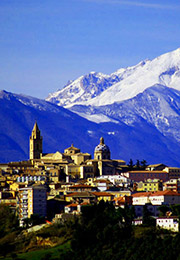 Chieti is amongst the most ancient of Italian cities. According to mythological legends, the city was founded in 1181 B.C. by the Homeric Greek hero Achilles and was named in honor of his mother,Thetis and thus called Theate (Greek: Θεάτη) (or Teate in Latin). As Theate Marrucinorum, Chieti was the chief town of the warlike Marrucini. According to Strabo, it was founded by the Arcadiansas Thegeate (Θηγεάτη).
Chieti is amongst the most ancient of Italian cities. According to mythological legends, the city was founded in 1181 B.C. by the Homeric Greek hero Achilles and was named in honor of his mother,Thetis and thus called Theate (Greek: Θεάτη) (or Teate in Latin). As Theate Marrucinorum, Chieti was the chief town of the warlike Marrucini. According to Strabo, it was founded by the Arcadiansas Thegeate (Θηγεάτη).
After their defeat against the Romans, the Marrucini became their loyal allies and later their territory was placed under Roman municipal jurisdiction after the Social War. In imperial times Chieti reached up to 60,000 inhabitants but, after the fall of the Western Roman Empire, it was destroyed by Visigoths and Heruli. Later it was seat of a gastaldate under the Lombard kings. After its destruction by Peppin, it became a fief of the Duchy of Benevento.
Chieti recovered some political and economic importance under the Norman rule of Southern Italy, a role it kept also under the Hohenstaufen, Angevine and Aragonese rules. After a cultural and architectonic flourishing during the 17th century, under the aegis of the Counter-Reformation, Chieti was again shattered by plague in 1656. In the 18th century it received several new academies and schools which further increased the city's artistic heritage. In 1806 Chieti was turned into a fortress by Napoleon's France. It became part of the newly created Kingdom of Italy in 1860.
During World War II, Chieti was declared an open city (like Rome) and was not bombed. The city at this time welcomed many refugees from the near towns and villages. Allied forces liberated the city on June 9, 1944, one day after the Germans left the city.
FOSSACESIA
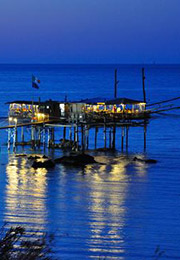 Fossacesia is a city in the province of Chieti in the Abruzzo region of Italy. The town is located on a small hill on the left of the Sangro River's mouth, c. 2 km from the Adriatic Sea.
Fossacesia is a city in the province of Chieti in the Abruzzo region of Italy. The town is located on a small hill on the left of the Sangro River's mouth, c. 2 km from the Adriatic Sea.
The main attraction of the neighbourhood is the Abbey of San Giovanni in Venere. The town is home to the Romanesque church of San Silvestro, dating to the 11th century.
PLACES OF INTEREST
The Fountain of Venus, a Roman fountain beneath the massive wall of the Abbey of San Giovanni in Venere where, according to a pagan tradition, women who wished to conceive a child went to fetch water. Today the fountain is in a state of extreme deterioration .
The laundry. It is composed of two rectangular contiguous stone tanks, one of which is shorter than the other. Currently the smaller tank is not directly visible from the road because it is closed by a structure of brick and concrete and accessible by a staircase.
The church of San Donato, built in 1905, rebuilt after bombing during the Second World War.
The church of Santa Maria delle Grotte. The church was built in the second half of the Thirteenth century by Cistercian - Gothic structures. The interior is decorated with French and Tuscan – late Giotto style frescoes.
The church of San Silvestro, founded in Villa Scorciosa in the Eleventh century. On 29 August 2009 it was rededicated and reopened to the public. The main façade is Romanesque. Above the portal there is a pointed arch, above which there is still a porthole window. In the right corner of the façade, on the roof, there is the bell tower.
The palace Contini ( 1770).
The palace Mayer ( mid-nineteenth century).
The casino Mayer on the road that from Fossacesia lead to the Abbey of San Giovanni in Venere .
The Town Hall, built in 1882.
The “trabocchi”, overflow wooden structures on stilts scattered along the coast that is so-called " coast of trabocchi".
MAJELLA NATIONAL PARK
The Maiella National Park ( Parco Nazionale della Majella, 740.95 km²) is a national park located in the provinces of Chieti, Pescara and L'Aquila, in the region Abruzzo, Italy.
It is centered around the Maiella massif, whose highest peak is Monte Amaro ( 2,793 m).
The area of the Majella national Park, especially the Montagna della Majella, has been subject to a major international geoscientific research Project, TaskForceMajella from 1998 up to 2005.
The park contains about 500 kilometers of hiking trails through the mountains, cave paintings in Grotta Sant'Angelo and Grotta del Cavallone (the latter being one of the deepest caves in Europe open to the public).
Tourist centers located in the park include:
Maurizio Locati Visitor Center, Colle Madonna, Lama dei Peligni - sections dedicated to chamois, archeology, a reconstruction of a Neolithic village, and the Giardino Botanico Michele Tenore.
Museo Naturalistico at Fara San Martino.
Paolo Barrasso Visitor Center at Caramanico Terme. It houses geology sections including fossils discovered on the Majella Mountain, and archaeologic findings from the Upper Paleolithic to the Roman age.
Giardino Botanico Daniela Brescia at Sant'Eufemia a Maiella

"Hotel Thousand and One Nights"


Close